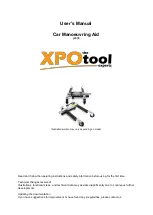
User Manual SMO1000A-S
61/176
Trigger Mode
The oscilloscope’s trigger mode includes auto, normal and single. Trigger mode affects
the way in which the oscilloscope searches for the trigger
After the oscilloscope starts running, the oscilloscope operates by first filling the pre-trigger
buffer. It starts searching for a trigger after the pre-trigger buffer is filled and continues to
flow data through this buffer while it searches for the trigger. While searching for the trigger,
the oscilloscope overflows the pre-trigger buffer and the first data put into the buffer is first
pushed out (First Input First Out, FIFO).
When a trigger is found, the pre- trigger buffer contains the events that occurred just before
the trigger. Then, the oscilloscope fills the post- trigger buffer and displays the acquisition
memory.
Press the
Auto
,
Normal
and the
Single
buttons on the front panel to select the desired
trigger mode, and the corresponding status light will be lighted.
In the
Auto
trigger mode (the default setting), if the specified trigger conditions are not
found, triggers are forced and acquisitions are made so hat signal activity is displayed
on the oscilloscope.
The
Auto
trigger mode is appropriate when:
Checking DC signals or signals with unknown levels or activity.
When trigger conditions occur often enough that forced triggers are unnecessary.
In the
Normal
trigger mode, triggers and acquisitions only occur when the specified
trigger conditions are found. Otherwise, the oscilloscope holds the original waveform
and waits for the next trigger.
The
Normal
trigger mode is appropriate when:
You only want to acquire specific events specified by the trigger settings.
Triggering on an infrequent signal from a serial bus (for example, I2C, SPI, CAN,
LIN, etc.) or another signal that arrives in bursts. The
Normal
trigger mode lets
you stabilize the display by preventing the oscilloscope from auto- triggering.
In the Single trigger mode, the oscilloscope waits for a trigger and displays the
waveform when the trigger condition is met and then stops.
The
Single
trigger mode is appropriate when:
To capture single event or aperiodic signal.
To capture burst or other unusual signals.
Содержание SMO1000A-S
Страница 1: ...Digital Oscilloscope SMO1000A S User Manual ...
Страница 50: ...User Manual SMO1000A S 50 176 Figure 12 x Interpolation Figure 13 Sinx Interpolation ...
Страница 76: ...User Manual SMO1000A S 76 176 Figure 28 Relative Window Trigger ...
Страница 78: ...User Manual SMO1000A S 78 176 Figure 29 Interval Trigger ...
Страница 82: ...User Manual SMO1000A S 82 176 Figure 32 Runt Trigger ...
Страница 96: ...User Manual SMO1000A S 96 176 Figure 44 SPI Trigger ...
















































